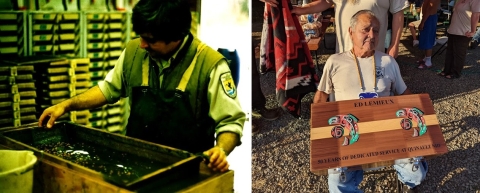To most people, a 50-year career means you’re past due for retirement. But John “Ed” Lemieux, a fish culturist at Quinault National Fish Hatchery (NFH), is showing no signs of slowing down.
“Figure I’ll keep working till I can’t,” Lemieux says with a chuckle.
Lemieux first provided support for Quinault NFH as a Bureau of Indian Affairs employee in 1971, which was just three years after the hatchery opened. The hatchery would call on Lemieux for maintenance support given his extensive skills with welding and construction. When a position opened at the hatchery in 1972, Lemieux was ready to compete. The allure of a permanent federal position and staying close to home was too good to pass up for this enrolled member of Quinault Indian Nation.
Let’s put Lemieux’s 50-year career into perspective. When he first started at the hatchery, it was the first year that more than 50% of television households in the U.S. had a color TV, and M*A*S*H was in its first year on television.
That year also marked the 100th anniversary of the Service’s Fish and Aquatic Conservation Program. Today, Lemieux has been with the Fisheries program for one-third of its 150-year existence. Let that sink in — for the 54,786 days of the program’s existence, Ed Lemieux has been doing his part as a public servant for 18,262 of them.
Lemieux’s impact was significant immediately after being hired on by the Service. He designed and fabricated a mechanical fish lift system, for example, to increase efficiency and reduce physical demands on the staff during spawning season. Prior to these custom improvements, staff had to manually net and lift thousands of adult salmon, which included Chinook salmon exceeding 30 pounds. It’s no doubt that he spared his co-workers from the usual sore backs during this busy and physically demanding time of year.
During the early years, Quinault NFH was working hard to establish salmon and steelhead returns to the facility.
“There was a lot of trial and error in those first few years,” said Lemieux. “It wasn’t until about 1975 before we started getting strong and consistent salmon returns.”
During Lemieux’s first 10 years, Quinault went from seeking surplus eggs from other hatcheries and capturing broodstock broodstock
The reproductively mature adults in a population that breed (or spawn) and produce more individuals (offspring or progeny).
Learn more about broodstock fish in the Quinault River, to providing eggs and fish for other hatcheries and Tribes. When asked about his favorite part of the job, Lemieux said it would have to be spawning season.
“It’s rewarding when you see your hard work paying off and there’s a lot of staff excitement and energy.”
During his tenure at the hatchery, Lemieux has spawned tens of thousands of salmon and steelhead. His hard work throughout each year has also contributed to the release of well over 150 million juvenile salmon and steelhead.
Fish production wasn’t the only thing to flourish during Lemieux’s tenure. He moved into employee housing in 1982 and his growing family became a fixture on the hatchery grounds. His seven children were essentially raised at the hatchery, and they all eventually worked at the facility through the Quinault Indian Nation’s Youth Opportunity Program as teenagers. Three eventually continued on with careers in fisheries conservation, including Jane, who was recently hired as a permanent biological technician at the hatchery.
Reflecting on his experience working with his kids, Lemieux said, “Sometimes we’re so busy and it’s so routine that I hardly notice. But you know how special it is when you have time to reflect.”
Lemieux’s family continues to grow, with 23 grandchildren, and four great-grandchildren. He enjoys having them over for visits, watching their sporting events, and hunting and target shooting with them. And he continues to serve as a role model and inspiration, as some of them are also showing interest in fisheries careers. It’s no doubt they have learned a great deal about hard work and dedication.
Lemieux’s impact, however, goes well beyond his family.
“It is impossible to overstate Ed’s contribution to the success of the hatchery,” said Quinault NFH manager Daniel Fielding. “Whether it be infrastructure, fish, or nurtured relationships with the Quinault Indian Nation and broader community, Ed Lemieux remains at the core.”
Lemieux clearly finds fulfillment in his work. When asked about the value of supporting his Tribal fishing community, he had a heartfelt response.
“It means a lot!” Lemieux said. “When I started, it meant a livelihood to people I knew. With almost no stream protection going on and quickly declining salmon returns, many Tribal fishers had to find other work. When the hatchery returns began to build, the Tribal fishers came back.”
Lemieux has clearly built an impressive legacy of hard work, dedication, results and inspiration. Just like the millions of salmon he has helped raise and release, he plans to keep on coming back to the hatchery again and again.





